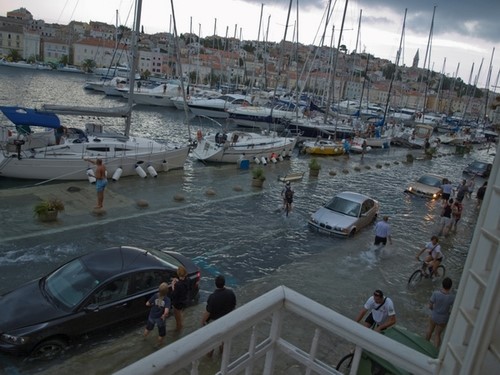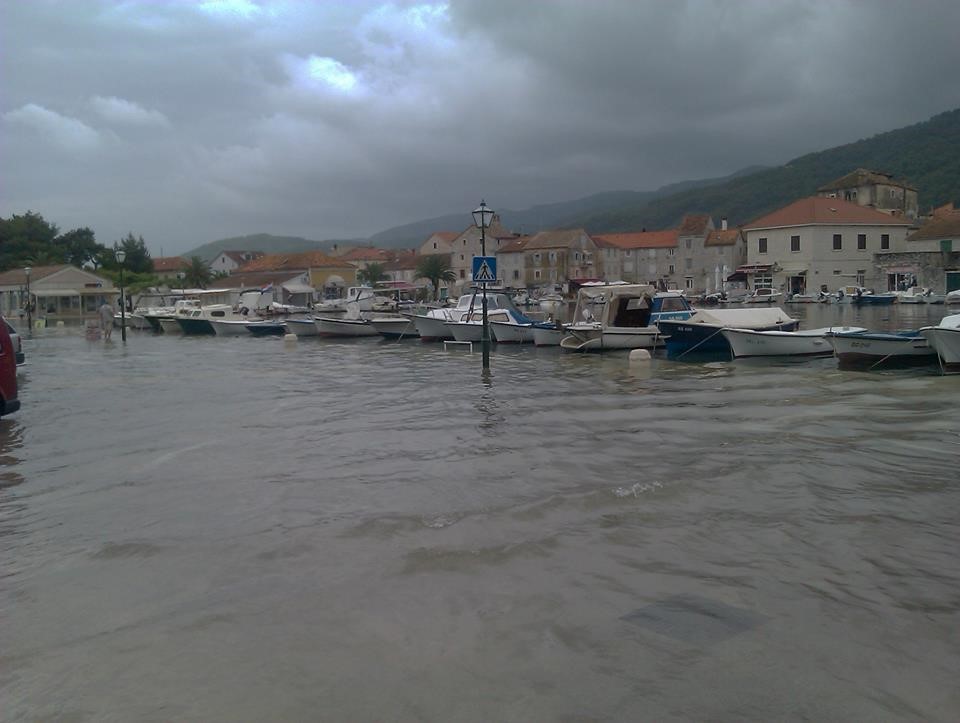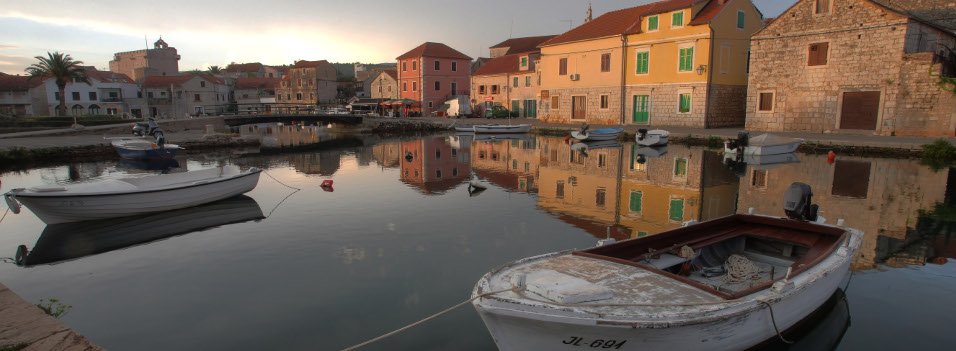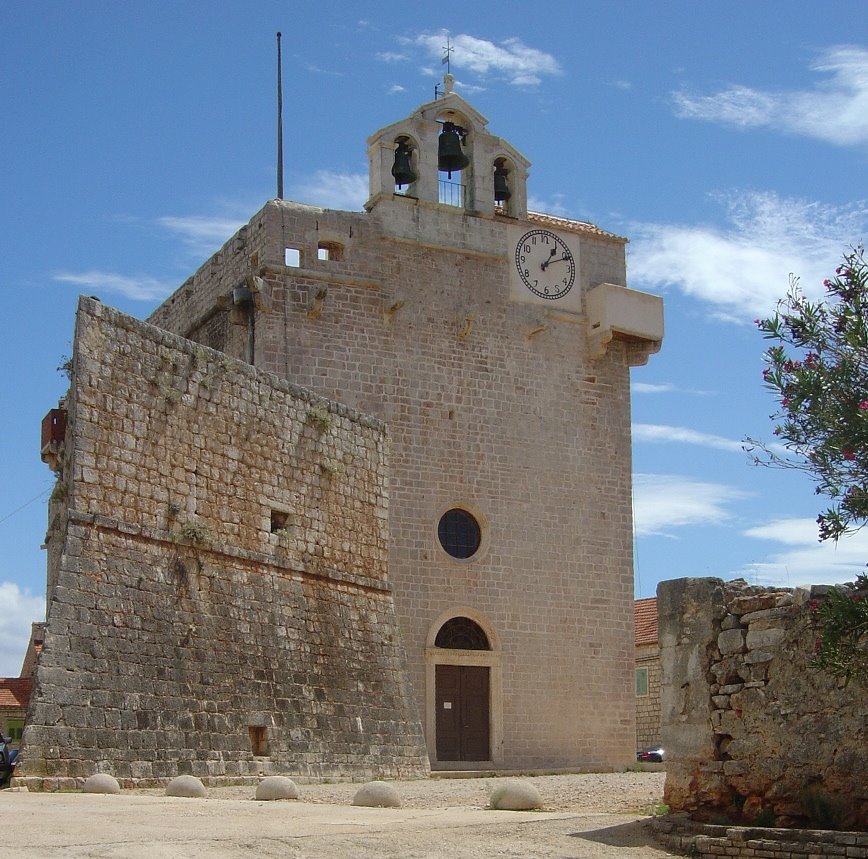




Catalogue of meteorological tsunamis in Croatian coastal waters



Meteorological tsunamis (meteotsunamis) are rare but hazardous long ocean waves, which have the same frequencies and spatial scales as tsunami waves. Meteotsunamis are, however, not related to seismic activity, volcanic explosions or submarine landslides, but to atmospheric forcing: pressure jumps, atmospheric gravity waves, frontal passages, squalls, etc. More often than not, the atmospheric forcing processes are relatively weak, and the generation of pronounced waves in the sea depends on the resonant transfer of energy from the atmosphere to the sea. Two types of resonance have been found to play role: Proudman resonance (Proudman, 1929) and harbour resonance (Honda et al., 1908). Proudman resonance occurs when speed of atmospheric forcing matches speed of long-ocean waves; and harbour resonance occurs when frequency of incoming long-ocean waves equal frequency of seiches in stricken harbour.

Destructive meteotsunamis are known to occur in Japan (Hibiya and Kajiura, 1982), Spain (Jansà et al., 2007), Great Lakes (Donn and Ewing, 1956), China (Wang et al., 1987), the eastern coast of the USA (Sallanger et al., 1995; Paxton and Sobien, 1998) and other locations (Monserrat et al., 2006). The eastern coast of the Adriatic Sea is among the world locations especially endangered by meteorological tsunamis. Furthermore, the strongest of the Adriatic events, the Great Vela Luka Flood of 21 June 1978, is likely the strongest known meteotsunami in the world: tsunami-like waves with trough-to-crest heights of up to 6 m and periods of about 20 min suddenly appeared, resulting in one of the greatest marine natural disaster in the modern history of Croatia with estimated damage of 7 million US dollars at that time, a quarter of annual income of the whole island of Korčula (Vučetić et al., 2009). Aside for the Great Vela Luka Flood, there appears to have been a number of other meteotsunamis in the Adriatic Sea: from the ones remembered only in local legends to the ones extensively researched.
The first version of this online catalogue had been taken over from a paper published by Mirko Orlić (The first attempt at cataloguing tsunami-like waves of meteorological origin in Croatian coastal waters, Acta Adriatica, 56, 2015, 83-95). The latter versions of the catalogue have been built by Jadranka Šepić and Mirko Orlić, by taking into account and scrutinizing the additional information as it became available.
The initial information used to build the present catalogue is contained in a couple of papers (Zore-Armanda, 1988; Tabain and Tabain,1994), as well as in the notes kept by Mirko Orlić over the last thirty or so years. For all the dates when tsunami-like waves possibly occurred, newspapers were inspected to find articles describing the waves. The first cases considered were from the early 1930s because prior events were usually attributed to the year only and are therefore not easily verified. Two verifications were performed for all of the dates. The first check was a comparison with an earthquake catalogue (Herak et al., 1996, with updates) to ensure that an event in the sea was not preceded by a major earthquake. It turned out that only one of the initial cases – the event of 15 April 1979 – was a tsunami, and it was therefore not included in the present catalogue. The second check was a comparison with sea level records from Bakar, the oldest Croatian tide-gauge station, with the aim of detecting a possible storm surge in the Adriatic on the day considered. Because the occurrence of tsunami-like waves of meteorological origin may coincide with the development of storm surge, inexperienced observers may easily confuse the two phenomena. Consequently, all cases when the sea level at Bakar surpassed the mean sea level by 50 cm were marked in the catalogue to indicate that additional data and/or modelling may be needed to verify their true nature. To each event, an indicator of the quality of available information was assigned. The indicator was selected from a five-grade scale as follows: (1) elementary description of sea-level variability; (2) advanced description of sea-level variability; (3) description of sea-level variability combined with an analysis of meteorological data; (4) analysis of oceanographic and meteorological data supplemented by oceanographic or meteorological modelling, and (5) analysis of oceanographic and meteorological data combined with both oceanographic and meteorological modelling.


Vrboska is a small village on the northern coast of Hvar island, built in the 15th century by inhabitants of a nearby village Vrbanj. At the end of the 16 century, villagers of Vrboska divided into two confraternities: one confraternity was in favor of separating Vrboska parish from the Vrbanj parish, and the other was against it. Within a few decades, discord between the two groups grew into true animosity.
Then, on 11 April 1614, a miracle happened. A girl Katarina Ordinanović (daughter of a sailor Petar Ordinanović) noticed tears of blood dropping from a crucifix in the Ordinanović family house. Shocked family called other villagers and pastor to witness the miracle. It was soon decided that the bleeding cross will be taken to the St. Mary fortress-church. While procession was taking place, a meteotsunami (šćiga) flooded the village - it was impossible to cross to the other side of village using a bridge - and procession had to go all the way around the bay, through disunited confraternities Podva and Pjaca. Christ's tears of blood and šćiga symbolically united Vrboska, and were seen as a sign that villagers have to make peace among themselves. Ever since, the story has been passed from one generation to another, and March Friday is up to this date considered to be one of the most significant religious holidays in Vrboska.


*March Friday is a Croatian catholic holiday of Miraculous Holy Cross. It is called March Friday, because it is celebrated on the first Friday in March.
If you have witnessed a meteotsunami (manifested as sudden flooding and/or drying of the coast), please use the following form to report the event, giving as much details as possible.
The first version of this online catalogue had been taken over from a paper published by Mirko Orlić (The first attempt at cataloguing tsunami-like waves of meteorological origin in Croatian coastal waters, Acta Adriatica, 56, 2015, 83-95).
The latter versions of the catalogue have been built by Jadranka Šepić and Mirko Orlić, by taking into account and scrutinizing the additional information as it became available.